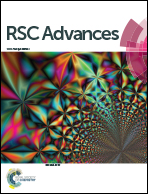Gold nanoparticle-enhanced near infrared fluorescent nanocomposites for targeted bio-imaging†
Abstract
Low toxicity and near infrared (NIR) fluorescent nanomaterials have many advantages in biological imaging. Herein, based on metal-enhanced fluorescence (MEF), novel NIR fluorescent nanocomposites (Au/SiO2/Ag2S core–shell microspheres) are designed and investigated. Characterization with UV, PL, TEM, FTIR and XPS confirms the fact that NIR Au/SiO2/Ag2S nanocomposites were prepared. The effects on the MEF including the metal core size (gold nanoparticles), and the distance between the fluorescent molecules (Ag2S nanoclusters (NCs)) and the metal core are systematically studied. The results show that the developed nanocomposites can effectively enhance the NIR fluorescence signal of the Ag2S NCs. A maximum enhancement is obtained when the nanocomposites contain a 25 nm gold nanoparticle core and a 34 ± 2 nm silica spacer. SiO2 as an important scaffold which could prevent NC aggregation and can be easily modified with functional groups (thiol, carboxyl and amine). These characteristics are beneficial for the further conjugation with folic acid (FA). FA-conjugated Au/SiO2/Ag2S nanocomposites show specific targeting of HeLa cells compared with 293T cells. With these properties provided, these nanocomposites have potential applications in distinguishing folate receptor-positive cancer cells from normal cells.


 Please wait while we load your content...
Please wait while we load your content...